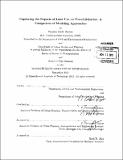| dc.contributor.advisor | P. Christopher Zegras. | en_US |
| dc.contributor.author | Hannan, Veronica Adelle | en_US |
| dc.contributor.other | Massachusetts Institute of Technology. Department of Civil and Environmental Engineering. | en_US |
| dc.date.accessioned | 2014-03-24T20:56:58Z | |
| dc.date.available | 2014-03-24T20:56:58Z | |
| dc.date.copyright | 2013 | en_US |
| dc.date.issued | 2013 | en_US |
| dc.identifier.uri | http://hdl.handle.net/1721.1/85919 | |
| dc.description | Thesis: M.C.P., Massachusetts Institute of Technology, Department of Urban Studies and Planning, 2013. | en_US |
| dc.description | Thesis: S.M. in Transportation, Massachusetts Institute of Technology, Department of Civil and Environmental Engineering, 2013. | en_US |
| dc.description | Cataloged from PDF version of thesis. | en_US |
| dc.description | Includes bibliographical references (pages 135-141). | en_US |
| dc.description.abstract | Most urban planning literature suggests that compact and mixed-use neighborhoods correlate with lower vehicle kilometers traveled (VKT), and accordingly, lower energy consumption and transportation-related emissions. However, many of these studies also find that the relationship between urban form and travel behavior is marginal at best, and several commit analytical errors, which may compromise the robustness of parameter estimates. This thesis examines daily travel behavior in Santiago de Chile to understand how demographic structure, neighborhood design, and regional accessibility influence travel behavior as measured through emitted grams of five criteria pollutants (C0 2, VOCs, PM10, CO and NO,). To answer this question, two different modeling techniques are employed to investigate the variables related to car ownership and travel behavior. The first analysis uses a discrete-continuous choice model to understand the attributes that influence car-ownership and travel emissions. The second study uses structural equation modeling to simultaneously estimate latent urban form factors, car-ownership and emitted pollutants. The advantage of each technique is that they both offer the flexibility to address the four major methodological errors identified in the literature review: inulticollinearity, spatial auto-correlation, the modifiable areal unit problem and self-selection. After controlling for the four methods-related gaps, both models find that, although economic and demographic characteristics dominate in explaining travel decisions, the built environment plays a small, but significant, role. The discrete-continuous choice model uses two classes of measures to capture urban form: local attributes and regional accessibility. It finds that neighborhood-level and regional characteristics have an equally important impact on 2 or 3-plus vehicle ownership.Furthermore, the model suggests that regional accessibility attributes dominate among the built environment measures in explaining variations in emitted travel pollutants. The structural equation model uses three latent urban form factors to characterize the built environment: a high-intensity, mixed-use factor; a high-income residential factor; and a non-gridded street factor. It finds that the high-density, mixed-use factor decreases the utility of owning a vehicle, and reduces the likelihood of travel emissions. The latter two factors, on the other hand, both increase the probability of owning a car. Lastly, the non-gridded street factor has a consistently positive effect on travel emissions. | en_US |
| dc.description.statementofresponsibility | by Veronica Adelle Hannan. | en_US |
| dc.format.extent | 141 pages | en_US |
| dc.language.iso | eng | en_US |
| dc.publisher | Massachusetts Institute of Technology | en_US |
| dc.rights | M.I.T. theses are protected by copyright. They may be viewed from this source for any purpose, but reproduction or distribution in any format is prohibited without written permission. See provided URL for inquiries about permission. | en_US |
| dc.rights.uri | http://dspace.mit.edu/handle/1721.1/7582 | en_US |
| dc.subject | Urban Studies and Planning. | en_US |
| dc.subject | Civil and Environmental Engineering. | en_US |
| dc.title | Capturing the impacts of land use on travel behavior : comparison of modeling approaches | en_US |
| dc.type | Thesis | en_US |
| dc.description.degree | M.C.P. | en_US |
| dc.description.degree | S.M. in Transportation | en_US |
| dc.contributor.department | Massachusetts Institute of Technology. Department of Civil and Environmental Engineering | |
| dc.contributor.department | Massachusetts Institute of Technology. Department of Urban Studies and Planning | |
| dc.identifier.oclc | 871338755 | en_US |
